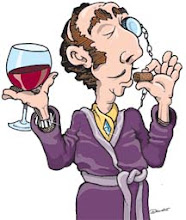The said wine is a little Tannat from Vinedo de los Vientos in Urguay. The wine is a late harvest Tannat called Alcyone. I immediately noted that the first wine was corked and whispered this to Kelly, the Sommelier (as I am the consulting Wine Director, I wanted the corkiness to be discovered by someone else). The wine was quickly dismissed by most at the table as crap (before it was announced un-fit). Then Louisa Hargrave smelled the wine and publicly noted it as corked. Kelly got a second wine and poured that around, I noted a nuance that bothered me so I thought it might be the glassware and rinsed my glass. The wine was not as obviously corked but still not right and with a hint of a 'corked' note. After that wine was dismissed as well we gave up.
After everyone dispersed, Kelly and I tasted a third bottle that had been opened and was being used for a by-the-glass pour. The wine was spot on, perfect. It was the type of wine that I can just smell and be satisfied. Notes of mocha, chocolate and fresh raspberries, once I did taste the wine all the acidity and balance that was lacking in the other wines was there in spades adn it was obvious that the wine would be perfect to pair with the dessert of Toffee Date Cake with Maple Walnut Ice Cream.
Unfortunately for the little dessert Tannat, Kelly and I conferred and decided to replace the wine for the James Beard Dinner with Patrick Bottex La Cueille Bugey Cerdon Rosé, a sparkling wine from the Bugey area near the Savoie area south of Geneva. The wine is a blend of Gamay and Poulsard (local grape of the area).
So now a bit on the concept of a so-called corked wine. I may eventually make this a separate posting but for now:
Chlorine is used to sanitize many things in our world and it is used in solution to sanitize cork for use in food products. So here we go with a bunch of chemistry...
Chlorine reacts with phenols ( a natural component of oak bark to produce 2,4,6 trichlorophenol (or TCP). TCP is then metabolized by molds growing on the bark to produce 2,4,6, tricholoranisole, aka TCA. It is kind of odd that the Chlorine and resulting TCP was introduced to kill the molds in cork for use in preserving wine and those molds help to create the evil TCA or the 'cork' in a so-called corked wine.
There are also Pentachlorophenols found in insecticides and wood preservatives that metabolized by mold to the dreaded TCA. Wood preservatives are sprayed on oak trees, wood palates, wood ships and construction wood. This has gotten some wineries in trouble infecting their entire winery with TCA and creating a situation that requires some severe solutions.
If you need to understand what a 'corked' wine tastes like, take a piece of cardboard and soak it in a glass of water for awhile...or consider the smell of a damp old cellar.
The major problem with TCA beyond the nasty smell is when that smell is not noticed...either by someone that doesn't understand this issue in wine or someone with a relatively low threshold for that smell, is that a low amount of TCA contamination will hide a wines aromas and cause the wine to taste dull. It has been studied and researched and scientists have found that as little as 1ppm (part per million) of TCA will cause a wine to 'loose' its fruit and character. Yet many people only notice the 'corked'/TCA smell down to 7ppm! So there is plenty of room for error. What this means is that a lovely wine can taste very boring and dull without tasting corked and therefore this is bad for the producer, sommelier, wine store merchant or anyone else in the chain of that wines trip to being consumed.
The ppm thresholds of TCA seem to be a moving target, I will be doing more research on this in the near future.
Here are a few links about the issue that I have found useful, but as I said, TCA thresholds seem to be a moving target.
